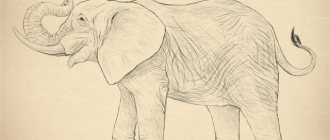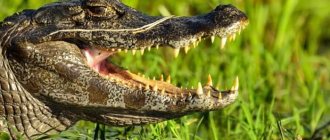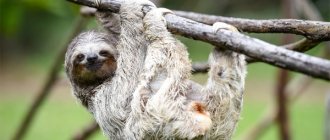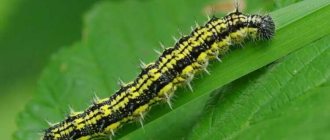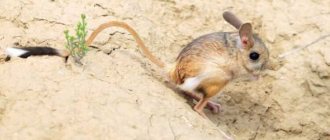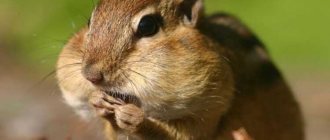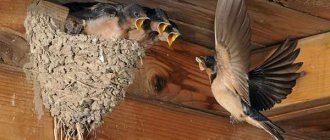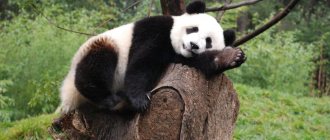Review author: “ZooVita”
Scientists did not immediately classify the bamboo bear or the giant panda animal as a bear. Initially, they were considered relatives of raccoons and even tigers and foxes. However, relatively recently, zoologists conducted genetic research and discovered the absolute similarity of pandas with the bear family.
From the photo of the panda you can appreciate the unique appearance of the bamboo bear. All of them are born black and white, with characteristic spots-circles framing the eyes, and absolutely black ears.
The coloring of the Big Panda is unique, as is the coloring of the Little Panda, which looks more like a fox or wolverine. But she is a representative of the canine family.
External features of a giant panda
Looking at the photo of the panda animal, you might think that this is a very good-natured and lazy creature. However, the panda is a real predator and can cause serious harm to humans.
The panda is a wild bear, which in the modern world is considered the property of China. The Chinese guard the panda population religiously. Exchange between zoos takes place according to the strictest rules.
According to the laws of the Land of the Rising Sun, it is prohibited to export pandas outside of China. Therefore, to the question of where pandas live, the answer is clear - in China. These are the mountainous regions of Shaanxi, Gansu, and Sichuan. The first mentions of pandas in the books of the inhabitants of the Middle Kingdom date back to 3 thousand years ago.
Enemies in the wild
In their natural habitat, pandas can feel completely safe. There are no large predators in their neighborhood, so black and white bears can calmly eat their favorite bamboo, without fear of attacks from four-legged hunters.
Pandas don't have to look around for threats
And yet, scientists believe that in the old days pandas had to fight off predatory animals. For example, they could fall prey to a member of the cat family such as the clouded leopard, which is found in the subtropical forests of Sichuan. True, given the fact that the weight of leopards is no more than 20 kg, they could hardly hunt adult pandas, and their prey most likely became immature cubs.
In the mountainous areas of western China and Tibet, another large predator is found - the red (also known as the mountain or Himalayan) wolf. These animals lead a gregarious lifestyle, and could easily attack pandas who did not even have a chance to defend themselves from a hungry pack.
But now both the clouded leopard and the red wolf, along with the panda, are listed in the International Red Book as very rare, endangered animals. And since pandas are constantly monitored by employees of protected areas, these predators do not risk approaching bears, preferring to stay away from human eyes.
Studying the animal panda
Research into the genetics and origins of these animals is still ongoing. In particular, it became known that the closest relative of the giant panda is the spectacled bear, which lives in the wild forests of South America.
Other scientists conclude that the bamboo bear is an independent species and does not need to be related to bears or raccoons. American researchers have published data indicating that pandas diverged from their relationship with bears about 20 million ago.
Why are pandas predators?
Considering the panda's diet, which consists of plant foods, people do not think at all that these are predatory animals. What do pandas eat? The answer lies in the names of these bears.
Pandas' favorite treat is bamboo stems. An adult can eat more than 25 kg of bamboo per day. In addition, the panda is very fond of fruits and also eats other types of vegetation.
Where does this large bear get protein for full life? The panda eats insects, eggs, fish, and small animals. By the way, what makes them similar to bears is that pandas are able to eat carrion.
Behavior of giant pandas
Large, bulky individuals move slowly, lie down, and constantly chew. To be satisfied, the panda is ready to eat within 12 hours. Bamboo bears move mainly on four legs, but quite often you can see pandas standing on their hind limbs to reach a treat. These bears are also excellent tree climbers and often sit on branches to take a nap or have a deep sleep.
Young pandas love to play. Be mischievous. They get into fights with each other, catch each other's arms and then begin to fight and roll around just like children.
The panda does not fall asleep for the winter, like most of its relatives from the bear family. During the cold season, bamboo bears move to habitats where it is warm all year round. Giant pandas live alone. The only exceptions are during breeding periods.
By the way, pandas are excellent swimmers, but they prefer not to get into the water again. Bears are hiding from the rain. Despite all this, scientists have noticed that pandas are very clean animals.
It seems to many that giant pandas make virtually no sounds. However, bamboo bears can roar so loudly that their voice can shake everything around them. In the wild, pandas live for about 20 years. In zoos - up to 30 years.
Features of character and life
This bear is very lazy. To the point that he is too lazy to even mate, look for a mate, and care for them.
As a result, the animal population is greatly reduced. In captivity, they can reproduce if conditions are favorable.
Often the male may not find a mate; this is due to the fact that bamboo forests are being intensively cut down. The mating season lasts only three days. The lifespan of animals in captivity is no more than 30 years.Pandas lead a reclusive lifestyle. It is very rare to meet couples. Animals mate only during the mating season to prolong the race.
Giant panda breeding
The birth of baby pandas in the wild is relatively rare. Scientists classify bamboo bears as fairly infertile animal species. But if a panda gets pregnant, it lasts about 5 months.
The cub is often born alone, and it is so tiny that in comparison with the size of its mother it is simply incomparable. Sometimes a mother panda gives birth to twins.
The panda takes care of its offspring with all responsibility and love. The babies grow very quickly and after a couple of months they no longer resemble little rats. cubs are very playful and are constantly looking for “adventures”. Mother pandas entertain their children as best they can. They play with them, often even waking them up on purpose to pamper them.
Where can residents of Russia see it in captivity?
Residents of Russia have been able to get acquainted with animals with reddish fur for the second decade by visiting the Moscow Zoo. First, back in 2009, there were two individuals on its territory that were already quite advanced in age by the standards of furry animals.
They arrived in the capital when they were ten years old. However, the animals quickly got used to it, did not show concern, and died of old age four years later.
By 2014, a young female appeared at the zoo, and two years later they added a very young male to her. At that time he was only one and a half years old. The animals have gotten used to it, but still do not lose their vigilance, they behave carefully, but not aggressively.
Even after many years, they react very anxiously to certain sounds. But not loud, pops and blows, but, on the contrary, slightly audible, different rustling sounds.
Perhaps this is due to instincts that help to escape from danger in the wild. Animals, accustomed to relying only on themselves, continue to listen, expecting an attack or invasion of their territory.
Red or red panda
This variety of panda is called fiery, red, red. These are very cute individuals that look more like foxes. However, scientists classify them as canines. The size of the red panda is slightly larger than that of a standard cat. Weighs up to 7 kg. The red panda has a wide head, a very cute pointed muzzle, and small round ears. The limbs are short, the claws are located so that the panda successfully climbs trees.
The color of this panda is unique. She has reddish fur. In some areas, the coat color may turn cinnamon or even black. The tail is long and very fluffy. There is a peculiar pattern around the eyes. It resembles a raccoon mask.
A little panda lives no more than 10 years. The lifestyle of these predators is mostly nocturnal. During daylight hours, the red panda sleeps in a hollow, curled up in a ball.
The red panda breeds its offspring in a secluded place. She gives birth to up to 4 cubs. Only 1-2 survive. Babies grow for a long time and are with their mother almost all the time.
The fire panda's habitat is wider than that of bamboo bears. In addition to China, they live in India, Nepal, and Myanmar. The red panda feeds mainly on bamboo stems, as well as mushrooms and small insects.
Dimensions and weight of a giant panda
Since the giant panda, unlike the small panda, belongs to the bear family, its weight and size are quite large, although by bear standards it is far from a giant. Interestingly, giant pandas can have huge deviations from the average height and weight. For example, the body length of a physically healthy giant panda can vary by one and a half times!
The range of weight fluctuations is absolutely colossal and the mass of individual individuals can vary by 9 times, although, of course, we are talking about comparing the largest and smallest individuals, which are very rare.
Dimensions and weight of an adult giant panda
The body length of an adult giant panda is usually 120–180 cm, height (at the withers) is 0.6–0.9 m, and weight varies widely – from 17 to 160 kg. Sexual dimorphism in giant pandas is not very pronounced, and the body length of an adult male of this animal is only 10% greater than that of females, and the weight is approximately 20% greater.
Dimensions and weight of a giant panda cub
On average, a giant panda cub weighs about 800 times less than its mother. As a rule, its weight is around 100 grams, ranging from 90 to 130 g. It is known that the heaviest cub of this animal weighed 210 grams, and the lightest weighed only 36 g.
The body length of a giant panda cub is 15–17 cm. The size of the babies is so modest that often zoologists, even using special cameras, are not able to examine the cubs hidden in the fur of their powerful mothers.
Average weight of a giant panda
On average, an adult giant panda weighs from 70 to 90 kilograms, and has a height at the withers of about 70 centimeters. Body length in most cases is 120–130 cm.
